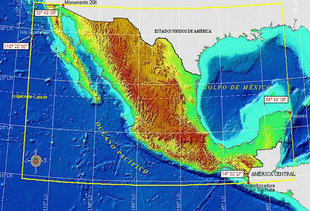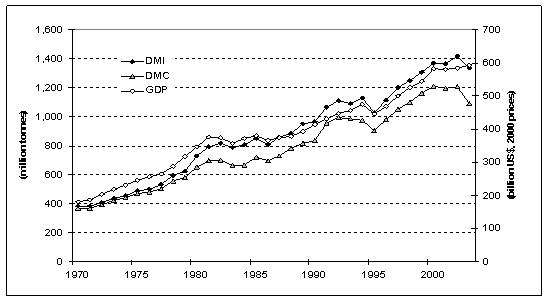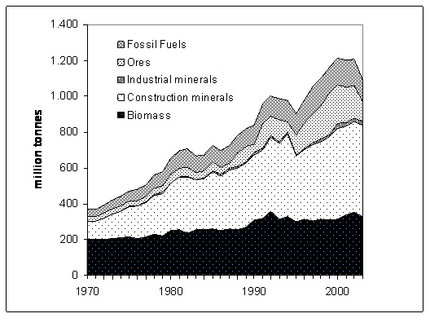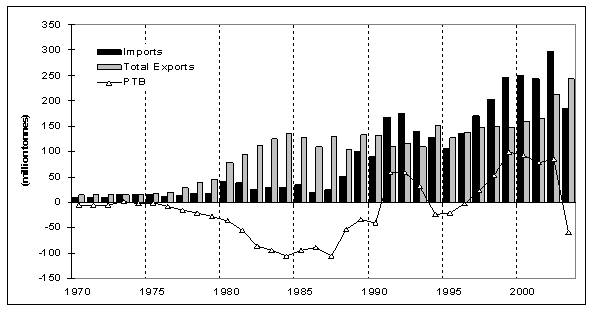Material use in Mexico: the metabolic transformation of a Latin American economy
With a land mass of 1,958,200km2 and 106 million inhabitants, México is one of the largest and most populated countries in Latin America. Considered as the second-largest economy in the region, it holds one of the highest per capita GDP in the Latin American region,$10,211 in current US dollars in 2008 (World Bank 2010).
 Figure 1. Mexico’s territory (Source: INEGI 2009)
Figure 1. Mexico’s territory (Source: INEGI 2009) But what does this economy look like in physical terms? What is the magnitude of its resource use? By accounting for the material inputs into an economy, material accumulation within the economy and outputs to other economies or back to nature, material flow accounting (MFA) provides an empirical assessment of the physical dimensions of an economic system. In this document, information on material inputs into the Mexican economy is provided for the period 1970-2003. Over these three decades, this economy experienced important transformations. México’s productive structure was modified, as a result of the implementation of radical economic reforms whose main objectives were stabilisation and growth, to be achieved through the liberalisation of the economy.
Information on the biophysical aspects of the Mexican economy have been gathered by applying standard methods for material flow accounting, and results are therefore internationally comparable[1].In particular, the MFA indicators obtained for Mexico are helpful to analyse the pressure this economy exerts on its natural resource endowment.
Despite low and uneven economic growth, the extraction and use of materials in the Mexican economy continuously increased over the period 1970-2003. Both MFA indicators, Domestic Material Input (DMI) and Domestic Material Consumption (DMC) tripled from 1970 to 2003, following the ups and downs of economic cycles (figure 2). By the end of this period, México’s domestic material consumption (DMC) per capita was 10.7 tons. This material consumption level is still well below the OECD average (15.6 tonnes in 2000) and the level in other Latin American countries such as Chile (44.5 tonnes in 2000). However, it is growing fast and the current resource use patterns may well present serious social and environmental problems to the medium and long term sustainability of this country.
When we look at the biophysical structure of this economy as measured by the DMC indicator, it is apparent that the main materials used are construction minerals (figure 3). This flow accounted for nearly half (47%) of the materials consumed in the Mexican economy in 2003, with fossil fuels comprising 12% and biomass 30%. The marked increase in mineral use is linked to a prevalent urbanisation trend due to the growing population, and the increasing importance of manufacturing and related built infrastructure.
México’s development strategy from the late eighties was based on a deliberate process of opening up the economy. Mexico has signed trade agreements with 43 nations, putting 90% of its trade under free trade regulations. Its most important trade agreement was established with the United States and Canada (NAFTA), allowing trade to triple in monetary terms since its ratification in 1994. Today, almost 85% of México's exports are delivered to the United States. In addition, México is a member of the OECD and the WTO. As part of the opening process, Foreign Direct Investment (FDI) inflows increased, which helped to trigger export-oriented manufacturing.
The process of México’s integration into global markets, as expressed by the amount of materials traded, has been impressive. Trade flows have shown a dramatic rise in terms of weight in the period 1970-2003. Annual imports grew from 8.5 to 185 million tonnes and exports went up from 14 to 243 million tonnes, resulting in a yearly growth rate of 9.8% and 9.05% respectively.
México went from being merely an oil-exporting country or “extractive economy” (Bunker 2007) to being a significant exporter of manufactured goods. The dependence on exports of raw materials in the monetary trade balance has decreased in recent years, and from 1992 to 2000 the Mexican physical trade balance (PTB) –imports minus exports- was even positive (Figure 4). In this process, the ‘maquila’ industry[2] played an important role. According to Dussel (2003), around 70% of México’s exports of manufactured goods are produced by assembling industries using imported inputs. The components that cross Mexican borders to be assembled in this industry are accounted for as imports, whereas the final goods once assembled are directly sent abroad and therefore accounted for as exports. According to De la Garza (2005) 96-98% of the total inputs used in these industries are imported. Assembling activities thus were responsible not only for the remarkable increase in Mexican trade, but also for its change in composition. According to foreign trade statistics (BANCOMEXT 2004) exports from assembling activities accounted for 47.7% of total Mexican exports and 35.3% of all Mexican imports, in monetary terms. These activities are concentrated in the automobile, auto parts and electronics industries (Dussel 2003).
Whether the assembling industry has positive effects for the national economy has been very controversial. Salaries prevailing in the assembling industry are low, there is a serious disconnect between the assembling industry and the other domestic industries, as most of their inputs are imported, and therefore, it has not had a spill over effect on the rest of the economy. Its contribution to domestic value added is rather limited. In addition, the environmental impacts of these activities can be high due to their geographical location. The majority of the assembling plants are located in Northern Mexico’s semi-arid border regions where the combination of meteorological conditions and topological disadvantages, with dynamic industrialisation and population growth, exert a growing pressure on the environment and natural resources; mainly on water. Water scarcity is becoming a crucial issue (Stromberg 2005).
Up to 2003, México showed signs of being a ‘hybrid’ case in the region, whose pattern of development places it between that of a typical Latin American economy (characterized by low GDP and an abundance of natural resources) and that of industrialized countries (based on strong industrial and service sectors, and a high dependence on imports for mineral ores, fossil fuels and other primary materials). Whether Mexico will be able to consolidate an economy based on high value added processes and products and less intensive in terms of material use, remains to be seen after the current economic crisis. Economic growth rate decreased to a modest 1.3% in 2008 (World Bank, 2010) and it is expected to turn negative in 2009 and 2010. This negative performance of the economy might be a bless for the environment as a drop in the material use is expected; given the tight relation between material use and economic cycles seen in Figure 2.
Delinking material use from economic performance in Mexico might be possible as long as a structural change takes place, modifying not only production patterns but life styles. In this sense, the current situation of crisis is a great opportunity for Mexico to redefine its human progress path.
References
- BANCOMEXT (Banco Mexicano de Comercio Exterior). 2004. World Trade Atlas. Banco de Comercio Exterior, Mexico, DF.
- Bunker, S. 2007. Natural values and the physical inevitability of uneven development under capitalism. In Rethinking Environmental History: World-System History and Global Environmental Change, edited by A. Hornborg, J. McNeill, and J. Martinez-Alier. Altamira Press, USA.
- Dussel, E. 2003. Ser o no ser maquila, ¿Es esa la pregunta? Comercio Exterior. 53(4).
- Eurostat. 2001. Economy-wide material flow accounts and derived indicators: A methodological guide. Luxemburg: Office for Official Publications of the European Communities.
- De la Garza, E. 2005. La maquila en méxico: Aspectos generales. In Modelos de Producción en la Maquila de Exportación. La Crisis del Toyotismo Precario, edited by E. De la Garza. UAM I- Plaza y Valdés, Mexico.
- González-Martínez, A.C. 2007. Material Flow Accounting of Mexico (1970-2003). Sources and Methods. Working paper 1-2007, Unit of Economic History. Autonomous University of Barcelona, Barcelona.
- Stromberg, P. 2005. La industria maquiladora mexicana y el medio ambiente; una revisión de los problemas. In El medio ambiente y la maquila en México: un problema ineludible, edited by J. Carrillo and C. Schatan. Colección Libros de la CEPAL, No.83. México: United Nations.
- WB (World Bank). 2007. World Development Indicators. www.worldbank.org/data.
Further reading
- González-Martínez A. C., and H. Schandl. 2008. The biophysical perspective of a middle income country: Material Flows in Mexico. Ecological Economics, 68 (1-2): 317-327
- Russi, D., A. C. Gonzalez-Martinez, J. Silva-Macher, S. Giljum, J. Martinez-Alier, and C. Vallejo. 2008. Material flows in Latin America: A comparative analysis of Chile, Ecuador, Mexico and Peru. Journal of Industrial Ecology. 12(5-6): 704-720
- González-Martínez, A.C. 2007. Material Flow Accounting of Mexico (1970-2003). Sources and Methods. Working paper 1-2007, Unit of Economic History. Autonomous University of Barcelona, Barcelona.
Notes


